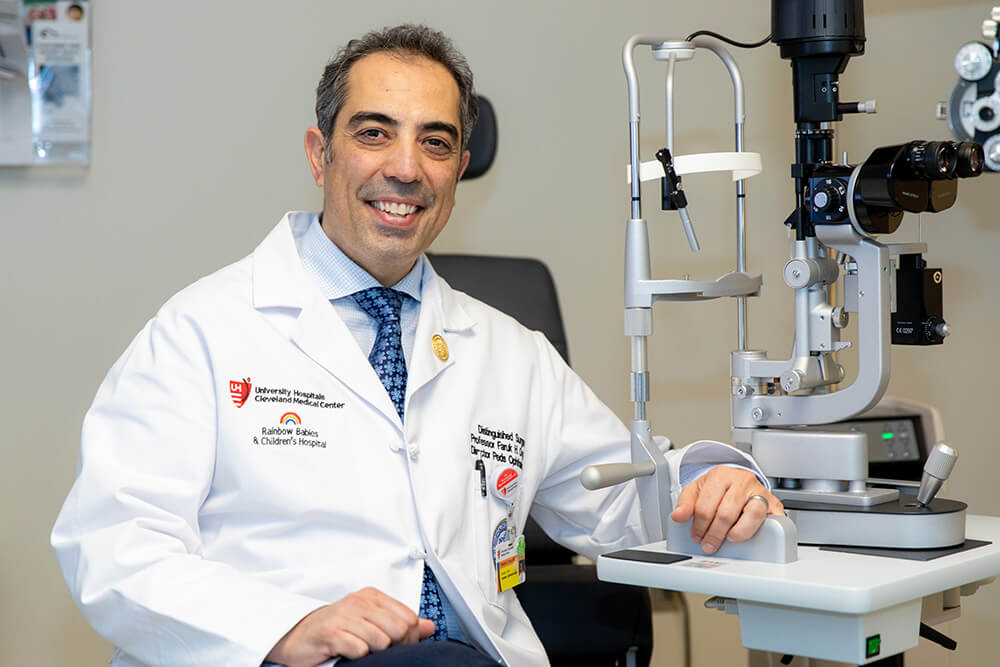State-of-the Art Ophthalmology Clinic at UH Rainbow Features Unique Ultrasound Technology
November 10, 2022

Tool invented in Cleveland only available at UH Rainbow
Innovations in Pediatrics | Fall 2022
Pediatric ophthalmology patients at UH Rainbow Babies & Children’s Hospital are the only patients in the world with access to 3-D ophthalmic ultrasound – a technology developed here and one of the many high-tech diagnostic and treatment planning tools available in the hospital’s new PRISM (Pediatric Research and Innovation in Sight & Motility) Clinic. This and other advanced technologies, plus the clinic’s central location within the hospital close to other related specialists, allow for some of the most integrated, comprehensive care for children and teens with eye conditions available anywhere in the country.
 Faruk H. Orge, MD
Faruk H. Orge, MDOne-of-a-Kind Technology
Faruk H. Orge, MD, Division Chief of Pediatric Ophthalmology and William R. and Margaret E. Althans Chair in Pediatric Ophthalmology at UH Rainbow, has collaborated for the past several years with engineers from Case Western Reserve University to develop the 3-D ophthalmic ultrasound technology, and it now has been implemented clinically at the hospital.
“It operates on the same principle as a CT scan or MRI,” Dr. Orge says. “We do one thousand cuts, one after another, and we’ve come up with an algorithm to collage them together, applying artificial intelligence and deep learning tools.”
The images created by the new technology provide Dr. Orge and his colleagues with intricately detailed views of relevant eye tissues, crucial in surgical planning and treating a variety of conditions, from eye tumors, to glaucoma, to cataracts to eye trauma or other eye anomalies.
“Particularly with eye anomalies, 3-D ophthalmic ultrasound allows us volumetric assessment and can detect details of the problem and help us understand the relationship between normal and abnormal structures,” Dr. Orge says. “A lot of the other technologies cannot show us that. Sometimes the only way to really see what's going on in the eyes is an ultrasound. So we went one step ahead and made it a three-dimensional modality and visualization.”
Other Features of PRISM
Other advanced technology used in the UH Rainbow PRISM Clinic includes optical coherence tomography (OCT), ultra wide-field photography, fluorescein and ICG angiography, visual field testing, red free photography and electrophysiology (ERG, VEP, VOP, etc.). At the same time, the clinic also offers simpler but still important technological options for its patients, such as animated shape-based vision charts for testing toddlers’ vision and electronic letter-based charts for testing older children -- charts that can’t be memorized during an eye exam.
“Even those little details are well thought-out, and we have them in every clinic,” Dr. Orge says.
Another key feature of the UH Rainbow PRISM Clinic, Dr. Orge says, is its role in multidisciplinary, team-based care. The clinic is a vital resource for patients with various conditions such as craniofacial issues, vascular anomalies, brain tumor, hydrocephalus, sickle cell disease and diabetes who are experiencing complications with their vision. Its central location at UH Rainbow makes collaboration among specialists seamless and efficient.
“We have this comprehensiveness,” he says. “Our location and the efficiency -- how we’re strategically located in the center of the hospital, closer to the other sub-specialists -- allow us to really work together. It can be almost a one-stop shop.”
Future Goals
Going forward, Dr. Orge and his colleagues in the UH Rainbow PRISM Clinic are planning to establish disease-specific clinics for complex conditions such as uveitis, pediatric cataract, glaucoma and anterior segment anomalies. And they’ll continue to meet their patients’ wide-ranging existing needs, from the child who simply needs a pair of glasses and contact lens to the child with a complex brain tumor. The technology and clinical expertise combined in the PRISM Clinic can address any vision problem that arises, Dr. Orge says.
“Whatever we need to do in any way, shape or form, we are able to do,” he says.
For more information about the PRISM Clinic at UH Rainbow Babies & Children’s Hospital, please email Peds.Innovations@UHhospitals.org.
Contributing Expert:
Faruk H. Orge, MD
Division Chief of Pediatric Ophthalmology and
William R. and Margaret E. Althans Chair in Pediatric Ophthalmology
UH Rainbow Babies & Children’s Hospital
Professor of Medicine
Case Western Reserve University School of Medicine


